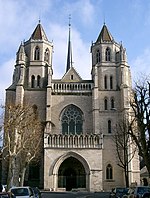Well of Moses
1390s works1400s worksArts in the court of Philip the GoodBuildings and structures in DijonHistory of Dijon ... and 5 more
Reliefs in FranceSculptures of angelsStatues of JesusTourist attractions in DijonVandalized works of art

The Well of Moses (French: Puits de Moïse) is a monumental sculpture recognised as the masterpiece of the Dutch artist Claus Sluter (1340–1405–06), assisted by his nephew Claus de Werve. It was executed by Sluter and his workshop in 1395–1403 for the Carthusian monastery of Chartreuse de Champmol built as a burial site by the Burgundian Duke Philip the Bold just outside the Burgundian capital of Dijon, now in France.
Excerpt from the Wikipedia article Well of Moses (License: CC BY-SA 3.0, Authors, Images).Well of Moses
Rue Blairet, Dijon La Gare
Geographical coordinates (GPS) Address Phone number Website Nearby Places Show on map
Geographical coordinates (GPS)
| Latitude | Longitude |
|---|---|
| N 47.32125 ° | E 5.01665 ° |
Address
Centre Hospitalier Spécialisé la Chartreuse
Rue Blairet 1
21000 Dijon, La Gare
Bourgogne-Franche-Comté, France
Open on Google Maps








